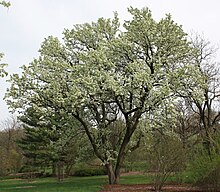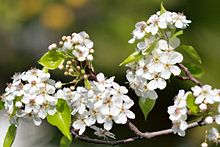Pyrus calleryana
| Pyrus calleryana | |
|---|---|
 |
|
| Pyrus calleryana | |
 |
|
| Callery pear blossoms | |
| Scientific classification | |
| Kingdom: | Plantae |
| Clade: | Angiosperms |
| Clade: | Eudicots |
| Clade: | Rosids |
| Order: | Rosales |
| Family: | Rosaceae |
| Genus: | Pyrus |
| Species: | P. calleryana |
| Binomial name | |
|
Pyrus calleryana Decne. |
|
Pyrus calleryana, the Callery pear, is a species of pear native to China and Vietnam, in the family Rosaceae. It is a deciduous tree growing to 5 to 8 m (16 to 26 ft) tall, often with a conic to rounded crown. The leaves are oval, 4 to 8 cm (1.6 to 3.1 in) long, glossy dark green above, and slightly paler below. The white, five-petaled flowers are about 2 to 2.5 cm (0.79 to 0.98 in) in diameter. They are produced abundantly in early spring, before the leaves expand fully.
The fruits of the Callery pear are small (less than one cm in diameter), and hard, almost woody, until softened by frost, after which they are readily taken by birds, which disperse the seeds in their droppings. In summer, the foliage is dark green and very smooth, and in autumn the leaves commonly turn brilliant colors, ranging from yellow and orange to more commonly red, pink, purple, and bronze. Sometimes, several of these fall colors may be present on an individual leaf. However, since the color often develops very late in fall, the leaves may be killed by a hard frost before full color can develop.
Callery pears are remarkably resistant to disease or blight though they are regularly killed by strong winds, ice storms, heavy snow, or limb loss due to their naturally excessive growth rates. Some cultivars, such as 'Bradford', are particularly susceptible to storm damage.
The species is named after the Italian-French sinologue Joseph-Marie Callery (1810–1862) who sent specimens of the tree to Europe from China.
In much of North America, cultivars of P. calleryana are so widely planted as ornamental trees that they have become a nuisance. The trees are tolerant of a variety of soil types, drainage levels, and soil acidity. Their crown shape varies from ovate to elliptical, at least until loss of limbs due to excessive and unstable growth rates. The initial symmetry of several cultivars leads to their attempted use in settings such as industrial parks, streets, shopping centers, and office parks. Their dense clusters of white blossoms are conspicuous in early spring, though their smell is commonly found unpleasant by many people. At the latitude of Pittsburgh, Pennsylvania, the trees often remain green until mid-November, and in warm autumns, the colors are often bright, although in a cold year they may get frozen off before coloring. In the South, Callery pears tend to be among the more reliable coloring trees.
...
Wikipedia
